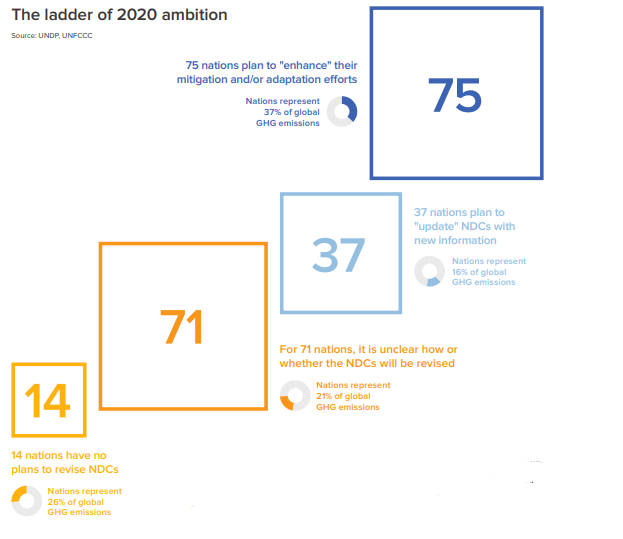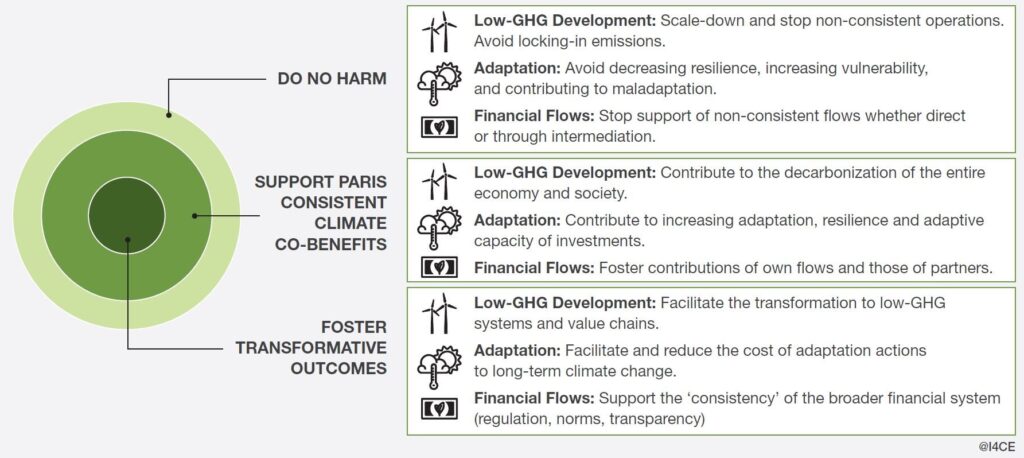From Paris to New York to Santiago: The Silver Lining of the 2019 UN Climate Action Summit
In September 2019 in New York City, the UN Secretary General Antonio Guterres convened a “United Nations Climate Action Summit” to increase the ambition and momentum of global climate action. While the outcomes of the Summit itself – particularly from country Parties – are seen as deeply disappointing, there are nevertheless a number of ‘silver linings’ to keep in mind on the road to Santiago. Alice Pauthier and Ian Cochran share four key ideas to focus efforts moving forward.
Countries must do more to provide ‘national visions’ or ‘pathways’ of their transition to a low-GHG and climate-resilient economy through their Nationally Determined Contributions (NDCs) and Long-Term Strategies (LTS)
The strength of the Paris Agreement is its call for all countries to define their national contributions to the three common long-term goals of the Paris Agreement on mitigation, adaptation and finance. However, this also requires them to provide a vision or pathway for the long-term evolution of their national economies towards a sustainable low-GHG and climate-resilient development. This represents a major change in defining national climate objectives and efforts from a top-down to a bottom-up and dynamic approach – with the objective of fostering acceptability and ownership by national governments. The Paris Agreement sets out two tools to provide this vision: concrete near-term Nationally Determined Contributions (NDCs) to be revised every five years, and guiding mid-century, long-term Low Greenhouse Gas Emission Development Strategies.
On one hand, the New York Summit was seen by many as a key – and in the end disappointing – milestone in the first NDC revision process due in 2020. In the run-up to the Summit, Antonio Guterres had asked countries “to present concrete, realistic plans, compatible with the latest Special Report on Global Warming of 1.5ºC by the Intergovernmental Panel on Climate Change, to enhance their Nationally Determined Contributions by 2020, reduce greenhouse gas emissions by 45 per cent over the next decade, and to net zero by 2050.” However, overall results were disappointing as only 75 countries – covering a relatively small share of global emissions – announced plans to revise and increase the ambition of their NDCs; and it increasingly appears that a number of countries may not revise upwards the ambition of their NDCs at all (see figure 1). Discussions at the Summit pointed to an increasing need for countries not only to take actions to scale-up ambition, but also move towards the implementation of NDCs – particularly the mainstreaming of climate change considerations across national policies and the development of investment plans needed to support NDCs.
Figure 1 : World’s pulse on intentions for 2020 taken by UNDP and UNFCCC for the Summit

Source: NDC Global Outlook Report 2019, PNUD and CCNUCC, 2019
On the other hand, we are seeing a positive trend in the roll-out of Long-Term Strategies that must be continued and scaled-up as countries are called to submit them before the end of 2020. Long-term Strategies can be a key tool in the transformation of economies and societies and avoid risks of locking in emissions or fostering maladaptation. These tools provide important transversal guidance on the long-term evolution of the different sectors of national economies. Research and practice have highlighted how the risks of focusing on near-term incremental action could prevent the economy from achieving long-term goals given the inertia of the economy; as such, these tools appear necessary to define short-term action plans consistent with long-term goals. Prior to the Summit, the NDC Global Outlook Report 2019 reported that 12 countries have submitted LTS to the UNFCCC since 2016, 53 countries are currently preparing LTS, while 44 more have plans to do so covering 86 percent of global GHG emissions. This is promising, but further efforts are needed for all countries to meet the 2020 deadline.
We are no longer talking about incremental GHG emission reduction – but rather the system transformation and the long-term decarbonization of our economies and societies
The Summit provided a clear and needed signal that climate change mitigation is now going beyond “least-cost” “low-hanging” fruit for mitigation – and that the transformation of the global economy and society towards long-term decarbonization is required. This was reinforced by many of the commitments made during or on the sidelines of the Summit that emphasized the importance of focusing on the contribution of near-term actions to achieve long-term climate goals:
- 65 countries and the European Union, joined by 10 regions, 102 cities, 93 businesses and 12 investors – all committed to net zero CO2 emissions by 2050;
- Companies with a combined market capitalization of more than US$2.3 trillion and annual direct emissions equivalent to 73 coal-fired power plants pledged to take action to align their businesses with science-based targets with the net-zero objective in mind;
- The United Nations-convened Net-Zero Asset Owner Alliance was launched, gathering institutional investors representing more than USD 2 trillion in assets under management to align portfolios with a 1.5°C scenario,
- The Zero Carbon Buildings for All Initiative pledged to make new buildings 100 percent net zero carbon by 2030 and existing buildings by 2050.
Furthermore, this is also entering thinking at the country level around the definition of Long-Term Strategies. Coming out of the Summit, it is increasingly clear that a clear pathway to carbon neutrality by 2050 will be the benchmark on which these strategies will be judged.
Progress is being made, but increased efforts are needed to systematically integrate adaptation and resilience in strategic planning and decision-making processes.
The month of September started with a call of the Global Commission on Adaptation to “take urgent action to advance climate adaptation solutions” and for “Three Revolutions for a Better Future”:
- “A Revolution in Understanding to ensure that the risks societies and economies face are fully understood—and reflected in the decisions that public and private actors make. A key element is the need to make risk visible, requiring more precise characterization of who and what is at risk—and why.
- A Revolution in Planning to improve how we make policy and investment decisions and how we implement solutions. Both the public and private sectors need to learn to better incorporate high levels of uncertainty in their decision-making, as choices will need to be made soon between radically different options—long before we know if the world will actually be on a 1.5°C or a 4°C pathway.
- A Revolution in Finance to mobilize the funds and resources necessary to accelerate adaptation.”
At the Summit a number of new commitments were made on adaptation and a range of different actors demonstrated a strong interest to step up action. Within the financial sector this included the launch of the Climate Resilience Principles for the US market by the Climate Bonds Initiative (CBI) the release for consultation of a new joint MDB-IDFC “Framework for Climate Resilience Metrics in Financing Operations” and the launch of the Coalition for Climate Resilient Investing, bringing together over 30 actors from across the investment value chain. However, further efforts are needed to put adaptation at the center of decision-making.
Economic and financial actors who have committed to align their activities with the long-term goals of the Paris Agreement must now take do it soon – and quickly.
The term of ‘Alignment’ with the goals of the Paris Agreement was heard across many of the discussions both at and in the margins of the Summit. In the financial sector, the attention to alignment builds on the commitment to align their activities with the Paris Agreement made by development finance institutions at the One Planet Summit in 2017 and a group of commercial financial institutions at COP24. In New York, the topic of Alignment was found at the heart of an increasing number of initiatives – such as the newly-launched Net Zero Asset Owner Alliance, the UNEP FI “Principles for Responsible Banking” (PRB), and the Partnership for Carbon Accounting Financials (PCAF) as well as significant new commitments from the multilateral development banks (MDBs) and the International Development Finance Club (IDFC).
Alignment approaches will vary as institutions may be involved in different types of business lines that have impact-oriented objectives or more commercial objectives.
- Many will be called to directly contribute to the achievement of the long-term climate goals;
- All will need to manage the risks and opportunities associated with the needed transformation of the economy and the financial environment; and
- All will need to take into account and respond to the changing physical climate.
Nevertheless, for all actors, being aligned requires that they scale-down and halt activities inconsistent with these goals and contributing whenever possible to national attainment of low-GHG climate-resilient development.
Ahead of the Summit, I4CE released an Alignment Framework, which specifies three dimensions for action. Building on an analysis of how the Paris Agreement has reframed climate action from a focus on the near-term incremental increase of adaptation and mitigation actions to emphasize the long-term transformation of economies and societies, I4CE’s framework for alignment requires that aligned institutions should seek to contribute to the ambitious goals of the Agreement across all of their activities and focus on the long-term objectives and national pathways to guide action.
Figure 2 : The Paris Alignment ‘Bulls Eye’: actively support national and international transformations across all activities

On the road from New York to COP25 in Santiago, discussions on these four topics will continue and we can hope that the perceived collective failure will be corrected in Chile to show real new ambition. Hopes are high that in Santiago we will see both increased ambition around NDCs and Long-Term Strategies that place the emphasis on the needed low-carbon resilient transformation of our economies and societies in line with the goals of the Paris Agreement.